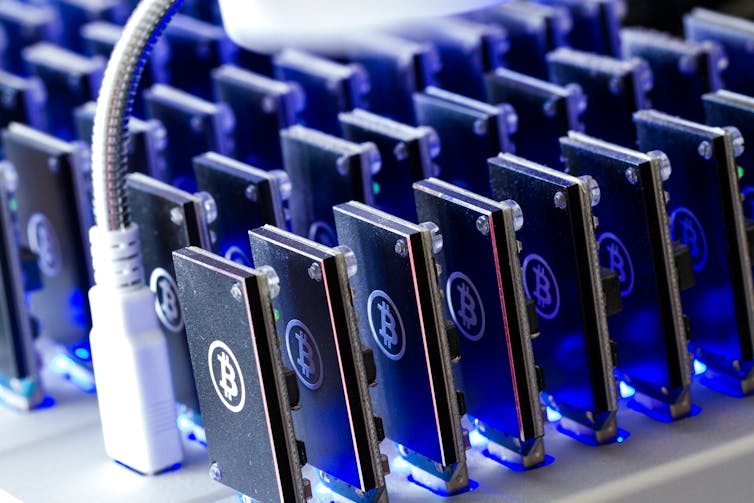Bitcoin's energy use is out of control … but maybe that's the point?
Courtesy of Mike Hazas, Lancaster University; Bingsheng Zhang, Lancaster University, and Joseph Lindley, Lancaster University

Arina P Habich / shutterstock
The soaring value of bitcoin is encouraging more and more companies and individuals to engage in “mining”. Mining is actually a process which secures the distributed bitcoin network, and processes all of its transactions. Historically anyone could do this using a standard PC, but these days hardware that is purpose-built for more energy-efficient mining is a necessity to mine profitably. Every ten minutes miners across the globe compete to the be the first to solve a mathematical puzzle. The winner gets the “block reward”, which is currently 12.5 bitcoins (at the time of writing worth more than US$200,000).
As the amount of mining activity increases, earlier concerns about bitcoin’s global energy consumption have become all the more prescient. However, it’s difficult to accurately estimate just how much energy is used, what the unit cost of that energy is, or whether its source was renewable. Nonetheless, one ongoing estimate says the total energy consumption of bitcoin adds up to almost 4GW (Gigawatts). That means the digital currency uses roughly as much energy as bulgaria.
Yet even this is likely to be too small a figure, given such estimates focus on the electricity used for mining and ignore the energy (and associated carbon emissions) that go into building and transporting new mining hardware, and then replacing it with the latest models every six months to a year.
Assuming bitcoin consumes about 4GW, then this would equate to about 1% of the electricity demand that goes into digital services and devices globally, or about 0.1% of total global electricity demand.
Comparing coins with kettles
Headlines about bitcoin’s energy footprint tell us how many kettles we can boil or how many miles we can drive per transaction. Whichever way we look at it, the answer is “a lot”. But while these figures help us relate the network and its transactions to everyday experiences, they don’t unpack why bitcoin is so energy intensive, whether using all this energy is “worth it”, nor do they point to future possibilities or alternatives.
0.000027 Bitcoin transactions? Natasa Adzic / shutterstock
To illustrate the problem with comparisons, consider iPads. To manufacture and transport an iPad to a customer has roughly the same carbon footprint as 225 sausages. Intuitively this seems like an excessively large pile of sausage, but it says nothing about the iPads’ share in overall consumer electronics sales, the typical useful lifetime of an iPad, how many sausages might be consumed in that time, nor the meaning and utility that people derive from iPads, relative to sausages.
We have to put bitcoin’s energy consumption into context: how much it consumes compared to other uses of computing power, what value or benefit mining creates (and for whom), and consequently what the appropriate alternatives might be.
Don’t compare bitcoin ‘per transaction’
Bitcoin is often compared to rivals like Visa, which manages far more transactions each of which uses much less energy. However, such “per transaction” comparisons are more complex than they might appear. Yes, it’s true that the computers required to “mine” digital coins actually use more energy, and ultimately create more carbon emissions, per unit of value created than the machines and resources used to print and mint traditional currency. When viewed like this bitcoin still seems wasteful.
However, bitcoin advocates would argue that’s an inevitable result of what makes cryptocurrency different. Unlike other forms of currency (say, the British pound) there is no central issuing authority. And unlike payment processors (say, Visa) there is no corporate core. The bitcoin network is designed to be distributed but secure, and is agnostic to energy consumption. In a world where bitcoin is considered a valuable asset, as it currently is, a significant – and growing – burden on global energy consumption is inevitable.
One alternative to the computationally (and electrically) expensive puzzles that underpin the mining process is a technology called proof-of-stake. Although technically viable, such a change would be controversial given that expensive bitcoin mining hardware would almost certainly be made redundant.
Bitcoin’s pseudonymous creator Satoshi Nakamoto is estimated to hold 1m coins (more than US$19 billion at today’s prices), while the overall network has “created” more than US$310 billion for miners. In wealth creation terms the digital currency experiment therefore appears to have been a success. Such success is a double edged sword though, as it has led three quarters of global mining being controlled by as few as five organisations (arguably undermining bitcion’s aim of decentralisation) and the environmental impact of the network’s unavoidable energy consumption is clearly problematic.
![]() Unless bitcoin changes to proof-of-stake the bubble is likely to end either in a financial or environmental catastrophe.
Unless bitcoin changes to proof-of-stake the bubble is likely to end either in a financial or environmental catastrophe.
Mike Hazas, Senior Lecturer in Human-Computer Interaction, Lancaster University; Bingsheng Zhang, Lecturer, Computing and Communications, Lancaster University, and Joseph Lindley, Research Associate in Speculative Design, Lancaster University
This article was originally published on The Conversation. Read the original article.




